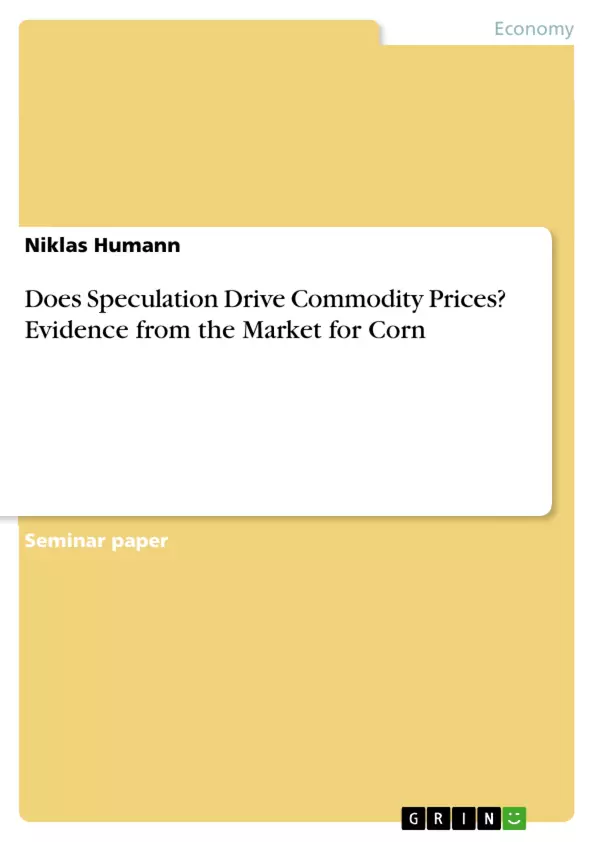This seminar paper reviews the literature on futures markets as well as the recent food crisis and presents an empirical investigation of the influence of (index) speculation on the corn price. My findings are in line with most of the other empirical conclusions that, rather than speculation, factors from the real and monetary economy played a role in the spike of commodity prices.
For centuries, corn has been one of the most produced crops in the world, used to feed people, livestock and machines. During the last quarter of the twentieth-century, world food prices declined by more than 50 percent, thereby improving the nourishment of people all over the world. However, this extensive decline also raised calls for protectionist policies, aimed at defending the welfare of commodity producers. Starting in the early 2000s, all classes of commodities have experienced hefty price increases. The price for corn increased by more than 250 percent in roughly three years (2005-2008). The resulting food crisis devastated low-income communities around the globe, with the already large part of their income they spent on food becoming even more substantial, causing hunger and malnutrition. While a variety of explanations for this crisis have been offered, some were quick to blame excessive (index) speculation.
Inhaltsverzeichnis (Table of Contents)
- 1 Introduction
- 2 Background
- 2.1 How Corn is Traded
- 2.2 Influences from the Real Economy
- 2.3 Monetary and Fiscal Policy
- 2.4 Structural Change
- 2.5 The Perfect Storm
- 3 Data
- 4 Methodology
- 5 Results
- 6 Conclusion
Zielsetzung und Themenschwerpunkte (Objectives and Key Themes)
This seminar paper investigates the influence of speculation on commodity prices, specifically focusing on the corn market. The paper analyzes historical data and employs econometric models to assess the relationship between speculative activity and corn price fluctuations.
- The role of speculation in commodity markets
- The impact of speculative activity on corn prices
- The interplay between real economic factors and speculation in the corn market
- The implications of structural changes and policy interventions on corn prices
- The use of econometric models to assess the relationship between speculation and prices
Zusammenfassung der Kapitel (Chapter Summaries)
- Chapter 1: Introduction Introduces the topic of speculation in commodity markets and its relevance to the corn market. It highlights the research question and the paper's objectives.
- Chapter 2: Background Provides an overview of the corn market, including how it is traded, the influence of factors from the real economy, the role of monetary and fiscal policy, and the impact of structural change and the "perfect storm" on prices.
- Chapter 3: Data Discusses the data used in the study, which includes historical data on corn prices, speculative activity, and other relevant economic variables.
- Chapter 4: Methodology Outlines the econometric models and statistical methods employed in the study to analyze the relationship between speculation and prices.
- Chapter 5: Results Presents the findings of the study, highlighting the results of the econometric analysis and their implications for the research question.
Schlüsselwörter (Keywords)
This paper focuses on the corn market, speculation, commodity prices, econometrics, real economy, monetary policy, fiscal policy, structural change, and the use of econometric models to analyze data. The study aims to uncover the impact of speculation on price fluctuations and to identify other key factors that influence the dynamics of the corn market.
- Citation du texte
- Niklas Humann (Auteur), 2020, Does Speculation Drive Commodity Prices? Evidence from the Market for Corn, Munich, GRIN Verlag, https://www.grin.com/document/1129104



